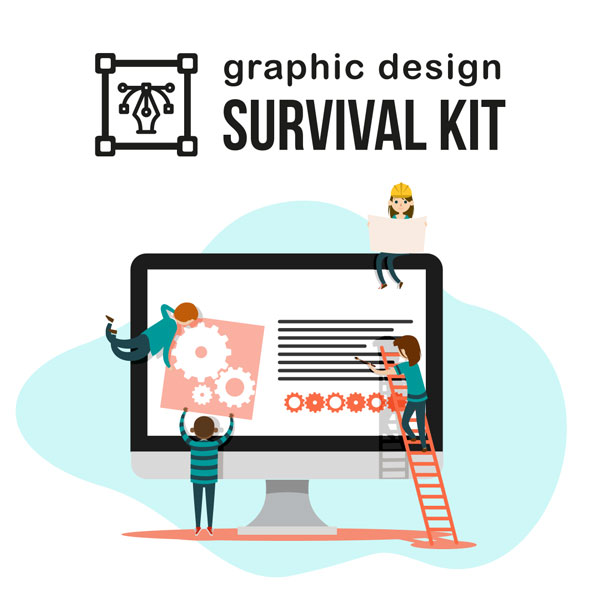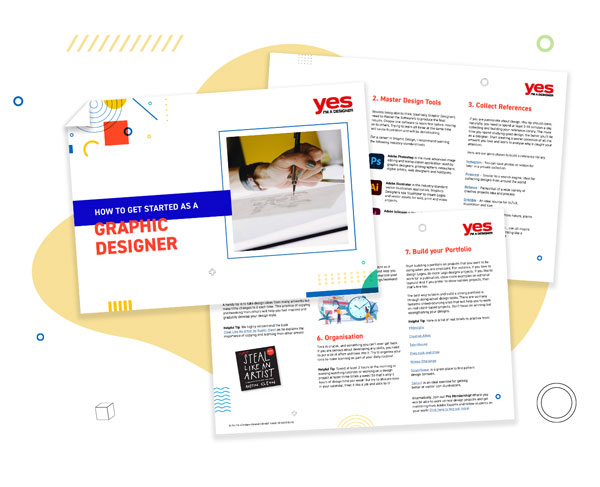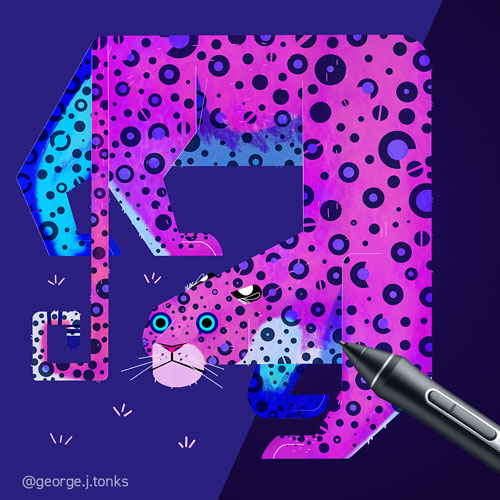
Starting a graphic design career can seem like an intimidating task...but that's where we come in! At YES, we have helped and taught thousands of students worldwide to improve their creative thinking and software skills through our Online Membership options!.
Today I want to personally share some tips that I have used to become a self-taught graphic designer and later an Illustrator. These tips will also apply to university students who want to fast-track their skills to become a successful designer as well anyone who wish to change their career.
Before we dive deep into these tips, I would like to summarise a little about what Graphic Designer roles involve!
A Graphic Designer essentially is responsible for creating visuals to either sell a product, service or promote a message. These visuals can be anything from Posters, Magazine to Web Banners. Graphic Designers do not need to draw. However, they must be creative and have technical skills to put beautiful compositions together using design elements such as Typography, Images and colour.
Now that we have that covered continue reading to find out more on how to get started as a graphic designer!
1. Passion is key
It sounds like a cliche, but you must have passion and love what you do to do it well. If you love doodling or looking through magazine layouts, playing around with colours, patterns and most importantly drawn to art and beauty? Then the good news is, creativity may already be built-in you. You need to practice on developing it!
Helpful Tip: Listen to our Podcast and decide whether
you are talented or not!

2. Master Design Applications - but ONE at a time!
Besides being able to think creatively Graphic Designers need to Master the Softwares to produce the final results. Choose one software to learn first before moving on to others. Trying to learn all three at the same time will cause frustration and will be demotivating.
For a career in Graphic Design, I recommend learning the following industry-standard tools:

Adobe Photoshop is the most advanced image editing and manipulation application used by graphic designers, photographers, retouchers, digital artists, web designers and hobbyists.

Adobe Illustrator is the industry-standard vector illustration application. Graphics Designers use Illustrator to create Logos and vector assets for web, print and video projects.

Adobe InDesign is the industry-leading page design and layout application used by designers to create books, newspapers, magazines, brochures, posters, flyers and digital publications. Understanding InDesign gives you precise control over typography, page layout and interactivity.
The order you wish to study can be determined by the type of projects you want to produce. Below I have listed a handful of tutorials which will help you learn Graphic Design skills!
This tutorial is a little dated, but the content is still relevant!
3. Collect References
If you are passionate about design, this tip should come; naturally, you need to spend at least 5-10 minutes a day collecting and building your reference library. The more time you spend studying good design, the better you'll be as a designer. Start creating a secret collection of all the artwork you love and learn to analyse why it caught your attention.
Here are my go-to places to build a reference library:
Instagram - You can save photos or videos for later in a private collection
Pinterest - Similar to a search engine, Ideal for collecting designs from around the world
Behance - Packed full of a wide variety of creative projects idea and process
Dribbble - - An ideal source for UI/UX, illustration and icon
Nature - Source inspiration from nature, plants and architecture
Daily life - Books, TV, food etc... can all inspire creative thinking! So start thinking like a designer in your everyday life!
4. Copy and Replicate
Once you built a reference library full of designs you love, now its time to replicate the artwork. YES! Copying does help you to improve your creativity. But you DO NOT sell or present artwork you recreated as your own! Remember, this is all about practice and learning and credit artists.
A handy tip is to take design ideas from many artworks but make little changes to it each time. This practice of copying and tweaking from others will help you feel inspired and gradually develop your design style.
Helpful Tip: We highly recommend the book Steal Like An Artist by Austin Kleon as he explains the importance of copying and learning from other artists!
5. Don't quit your day job (yet)
Don't leave your day job until you get a good offer! Money worries will put pressure and stop you from progressing. Instead, try to learn and improve your skills in your spare time either in the evenings/weekend to build a strong portfolio.

Are you interested in becoming a Graphic Designer or Illustrator?
Join 10,000+ creatives and subscribe to our FREE Graphic Design Survival Kit newsletter.
You’ll get instant access to our resource library and feel well equipped to make that next big leap in your design career.
6. Organisation
Time is crucial, and something you can't ever get back. If you are serious about developing any skills, you need to put a lot of effort and time into it. Try to organise your time to make learning as part of your daily routine!
Helpful Tip: Spend at least 2 hours in the morning or evening watching tutorials or working on a design project at least three times a week! So that's only 6 hours of design time per week! But try to allocate time in your calendar, treat it like a job and stick to it!
7. Build your Portfolio
Start building a portfolio on projects that you want to be doing when you are employed. For instance, if you love to design Logos, do more Logo designs projects. If you like to work for a publication, show more examples on editorial layouts! And if you prefer to show various projects, then that's fine too.
The best way to learn and build a strong portfolio is through doing actual design tasks. There are so many fantastic crowd-sourcing sites that will help you to work on real client-based projects. Don't focus on winning but strengthening your designs.
Helpful Tip: Here is a list of real briefs to practice from:
99designs |Daily UI | Fake Clients |Minted.com | Theydrawandcook.
Alternatively, Join our Pro Membership! Where you will be able to work on real design projects and get mentoring from Adobe Experts and fellow students on your work! Click here to find out more! or download our sample briefs.
I highly recommend watching these tutorials on building your portfolio as well as working for Crowd-sourcing sites: 99design!
8. Ask for feedback and accept Critiques
Design is very subjective, and your artwork may not always meet the brief or appeal to everyone. However, to grow and improve as a designer, you need to be able to accept negative feedback! Try not to become defensive or try to justify your work. Those negative feedback will help you to learn and grow.
9. Show off your work
As a designer, you need to learn to market yourself and show off your work. We understand standing out is tough, but the reality is the more you connect and have an online presence, the higher chance you have to get noticed and potentially hired.
Build your portfolio online and share on sites such as Behance and Dribbble. Submit your best designs to forums such as Adobe fan page. Attend creative meetups such as Behance portfolio reviews and start sharing your creative process on Instagram.
Helpful tips: Being on many platforms will become challenging to manage, leaving you feeling overwhelmed and unmotivated! Instead, spend time on one or two that you like to use the most.
10.Network and Collaborate
It is always daunting to meet new people, but a lot of designers who attend events are more likely to make valuable connections and be exposed to new opportunities.
Here are are some networking things you can do!
- Attend creative events and Meetups
- Art fairs + Galleries
- Take part in workshops!
(If you prefer, there are lots of online networking events as well)
Bonus Tip: Keep an eye out for remote job opportunities
The best way to keep your finger on the pulse of the market is checking Jooble a few times a month. You can subscribe to alerts, even upload your CV directly.
See the latest graphic designer jobs here.
I hope that you found those tips useful and feel inspired to kickstart your design career! Your journey will, at time be very challenging, but designing something beautiful is incredibly rewarding. Good Luck!

Do you want to become a Graphic Designer?
Sign up to our newsletter, and you’ll get instant access to our resource library, including this guide to becoming a Graphic Designer!

UP NEXT
We will highlight six key steps to help you define your illustration style
LEARN ADOBE APPLICATIONS
from Adobe Certified Instructors and industry professionals





